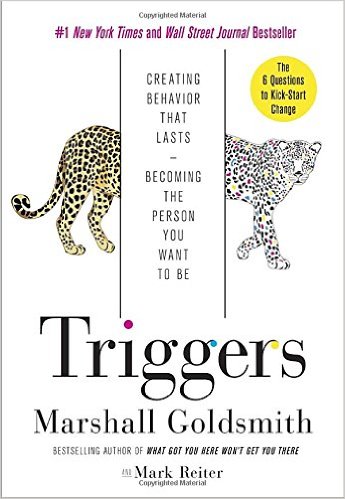In the next week, I’ll be publishing a list of 5 books I recommend for leadership book clubs. A new addition is my favorite book this year: Triggers by Marshall Goldsmith. Here is why.
I believe that great conversations start with a question. Marshall Goldsmith asks some great questions in his book Triggers.
Some of the best:
- What is the most memorable change you have made in your adult life?
- Did I do my best to set clear goals?
- Did I do my best to make progress toward my goals?
- Did I do my best to find meaning in my work?
- Did I do my best to be happy?
- Did I do my best to build positive relationships?
- Did I do my best to be fully engaged?
- Am I willing, at this time, to make the investment required to make a positive difference on this topic? (called AIWATT for the rest of this post)
There are many reasons I love this book, and the main one is the author’s sharing of powerful questions that he has accumulated in his career as an executive coach. This post will focus on the significance of question #8, and how you can use it as a leader.
In a recent EOS quarterly, a leader shared a learning – “When we set goals, we need to make sure we set them so we can be excited about them and use that energy to complete them.” That is a powerful learning, and something that every leader needs to be thinking about when they accept a To Do or a Rock (quarterly goal). The AIWATT question is the action to ensure this happens.
Remember my 5 Tips for Managing Your Career and Performance? The first tip is Own It, and it is my way of saying what Goldsmith does by posing this question to us. If you answer No to AIWATT, then some other conversations need to happen.
This brings me to a second belief I have – Leadership is about honest conversations that lead to thoughtful actions and improved performance. One of the powerful outcomes for me from Triggers is that, as a coach, I need to always be focusing on creating space that allows honesty to happen, because that is the hard part. In my experience, thoughtful action is the easier part.
Two myths that leaders need to remember:
- We need to love 100% of our work. There is an eastern adage: Before enlightenment, chop wood and carry water. After enlightenment, chop wood and carry water. Here is an example: I don’t like confronting people I don’t know. However, as president of an all-volunteer athletic booster organization, one of my roles is to call volunteers who have made commitments and are not doing the work. It is my job and the team depends on my doing it – so I do it because I have to, and make sure I overbalance it with other tasks I enjoy doing.
- We have to do 100% of our work. Delegating pieces of our work to others who have more talent/passion for that work is fine. Just don’t always pass on the hard conversations, and tell them why you are asking for their help – because they are better at it/more passionate about it.
Let me propose two actions:
- For EOS leaders: Teach the AIWATT philosophy. As you go through the To Do list, ask people to answer the AIWATT question with the caveat that if the answer is No they acknowledge who they will ask for help – or that I will Own It (and use those words). *Note: Make a note for anyone answering the latter, and follow-up with them one-on-one to do some micro-supporting.
- For individuals: Put an AIWATT on two post-it notes and stick one to your computer screen and one to your phone for a week. Ask yourself that question continuously during meetings, when you answer emails, and when you do any morning/evening quiet time. After a week, do 5 minutes of personal reflection with the question, “How did AIWATT impact my leadership this week? Of myself? Of others?” If this reveals something for you that you need to bounce off someone, just call me and we can do a 15-minute coaching session: 616-405-1018.
I believe . . . great conversations start with a question.
Leadership is . . . having honest conversations that lead to thoughtful actions and improved performance.
Lead well . . .

